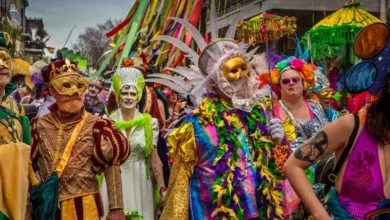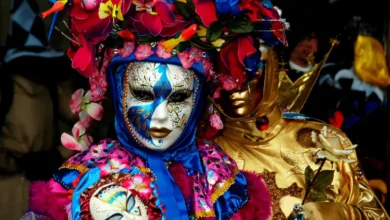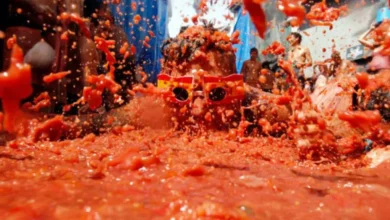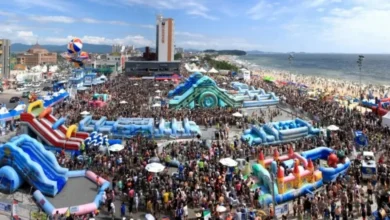Table of Contents
Do you want to dive into Japan’s culture? Then check out its rich festival scene, known as matsuri. These events let you see deeply into Japanese traditions and joy all year round.
In the spring, enjoy the stunning cherry blossom parties. Feel the fun of summer’s Obon dances. And in winter, witness the magic of Shinto shrine gatherings. Japan has something for everyone, from lively parades to beautiful dances and cool snow art.
Where should you go to see Japan’s festivals? Get ready for an amazing journey through Japan’s matsuri. Feel the heartbeat of its culture and witness its captivating beauty and spirit with every event.
Takayama Festival: A Celebration in the Japanese Alps
In the Japanese Alps, Takayama shines with its Takayama Festival. This biannual event is a time of joy in both spring and fall. It shows off the area’s deep cultural roots and talented craftsmen.
Sanno Festival: Welcoming Spring and Prosperity
The Sanno Festival welcomes spring in a beautiful way. When cherry blossoms fill the air, people head to Hie Shrine to celebrate. They pray for peace and a good harvest. The festival also boasts karakuri doll marionettes, making everything lively.
Hachimangu Festival: Illuminated Floats and Artisan Craftsmanship
Autumn’s Hachimangu Festival is all about showing thanks. It highlights Takayama’s unique crafts and arts. The highlight is the yatai-hikimawashi, a parade of 17th-century wheeled floats. These feature amazing designs by local artisans.
The Takayama Festival is among Japan’s top celebrations. It stands with the Gion Festival in Kyoto and the Chichibu Night Festival in preserving tradition. All three are vital parts of Japan’s rich cultural heritage.
Aomori Nebuta Festival: Vibrant Warlord-Shaped Lanterns
The Aomori Nebuta Festival is a big deal in the Tohoku region, happening in early August. It started with the Tanabata star festival. Now, it’s famous for its huge, “nebuta” warlord-shaped lanterns. Over three million people come to see these unique lanterns.
Teams of 300 work for three months to make the massive nebuta floats. They can be as tall as five meters and as wide as nine meters. As they’re paraded, you’ll hear the crowd shout “Rassera!” with dancers and musicians all around.
On the last day, the lanterns are set to drift in Aomori Bay. This tradition is to wash away bad luck and wish for a good, long life.
| Festival | Location | Key Attractions | Attendance |
|---|---|---|---|
| Aomori Nebuta Festival | Aomori, Tohoku region | Vibrant warlord-shaped lanterns, parade with dancers, taiko drums, and flutes | Over 3 million visitors |
Sapporo Yuki Matsuri: A Winter Wonderland of Snow and Ice
In the snowy winters of Hokkaido, the Sapporo Snow Festival shines. It’s a huge event, known as one of the top snow festivals in Japan. It began in 1950 with small snow sculptures created by local high school kids. Now, over two million people come each year to see the big snow and ice sculptures.
International Snow Sculpture Contest
From the Sapporo TV Tower, you can see all the festival’s amazing sites. It offers a great view of the detailed snow sculptures. At the International Snow Sculpture Contest, teams from worldwide gather. They compete to create the best snow sculptures.
Illuminated Snow and Ice Sculptures
The Susukino site is famous for its illuminated snow and ice sculptures. They glow and create a magical scene at night. As the day ends, the lights turn on. The festival becomes a dazzling winter wonderland.
Family-Friendly Snow Activities
This festival is not just about the sculptures. It also has family-friendly snow activities for everyone. You can enjoy snow rides, snowball fights, and snow slides at Tsudome. There’s also an ice rink and curling games. It’s all about having fun and celebrating winter in Hokkaido.
Michinoku Yosakoi Festival: A Dynamic Fusion of Dance and Music
In mid-October, Sendai hosts the Michinoku Yosakoi Festival. It’s Japan’s third-largest Yosakoi event. Yosakoi started in 1954 and is famous for its lively dances. Over 150 teams and 5,000 dancers from Japan join. They wear colorful costumes and dance to a Tohoku folk song, showing the happiness of life.
Unique Team Costumes and Performances
This festival occurs in Kotodai Park and Jozenji Avenue. Naruko clappers sound and mix of rock and traditional music fills the air. People love the teams’ bright costumes and well-choreographed dances. They make the festivals of Sendai and Tohoku feel real and full of life.
Celebrating the Joy of Life
The Michinoku Yosakoi Festival is all about enjoying life. Each team combines costumes, folk songs, and dancers’ excitement in their performance. These elements create an unforgettable spectacle. It honors the deep cultural roots of Tohoku.
Where can I experience traditional cultural festivals in Japan?
Japan has many cultural festivals, from Sapporo’s ice sculptures to Aomori’s lantern parades. There, you can experience Yosakoi dances, or the quiet moments of a Shinto ritual. These events showcase Japan’s beauty and tradition in various ways.
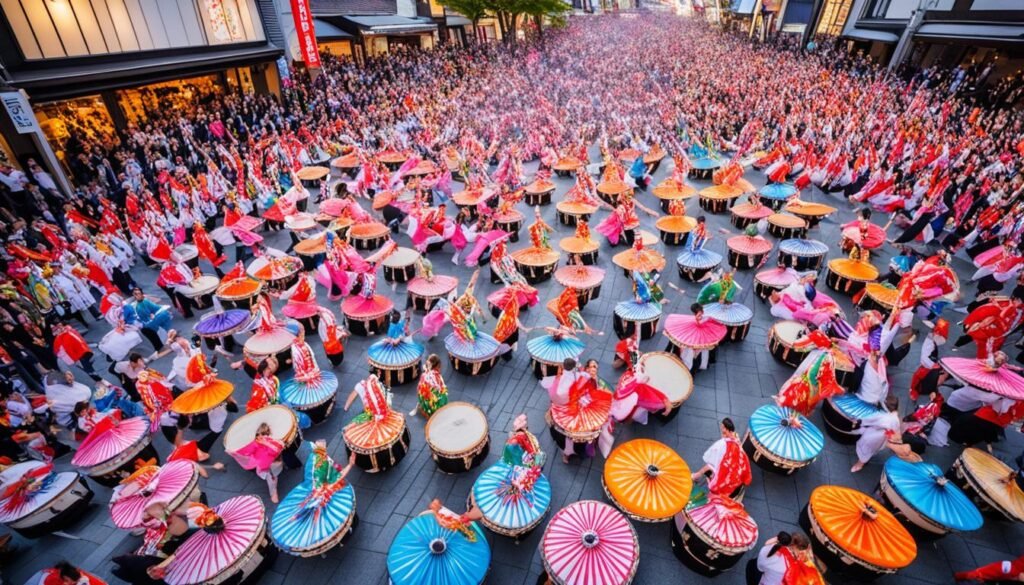
Awa Odori: Japan’s Biggest Traditional Dance Festival
In mid-August, the Awa Odori Festival lights up Tokushima. It’s Japan’s top traditional dance celebration, drawing a crowd of over a million each summer. This event features the Awa Odori dance, a special type of Bon Odori performed to honor ancestors during Obon season.
Vibrant Yukata Costumes and Ami Gasa Hats
The Awa Odori is a fun-filled, spirited dance-off. Teams clad in colorful yukata and adorned with ami gasa hats compete in a lively manner.
The “Fool’s Dance” and Celebration of Joy
This dance is known as the “fool’s dance.” Its tale comes from a time when victorious soldiers danced recklessly in front of a castle. The merriment at the festival is inclusive, with a popular chant being, “The dancers are fools, and the watchers are fools. Since both are fools, why not dance?”
Izumo Taisha: Welcoming the Gods of Shinto
On January 3rd, the Izumo Taisha festival takes place in the Shimane Prefecture. It’s one of Japan’s key Shinto celebrations. In the 10th lunar month, known as Kamiari-zuki, roughly eight million Shinto deities come together at Izumo Taisha. They discuss the year’s events. This festival draws over two million people. They come to see the gods being welcomed.
The Month of the Gods (Kamiari-zuki)
In the Month of the Gods, about eight million Shinto deities meet at the Izumo Taisha. They talk about what’s happened during the year. This yearly gathering is a big part of Japan’s Shinto practices. It brings in millions of visitors to witness the arrival of the gods.
Izumo’s Culinary Delights
Besides the Izumo Taisha festival, Izumo is well-known for its unique food. This includes Izumo Soba noodles and Shimane Wagyu beef. Guests can enjoy these local treats. They reflect the area’s culinary excellence.
Exploring Izumo’s Natural and Cultural Treasures
When in Izumo, check out its natural and cultural offerings. Visit the Hinomisaki Lighthouse, the biggest stone lighthouse in Asia. And see the lovely Tachikue Gorge. It’s filled with Buddhist statues. These places show Izumo’s colorful history and natural beauty.
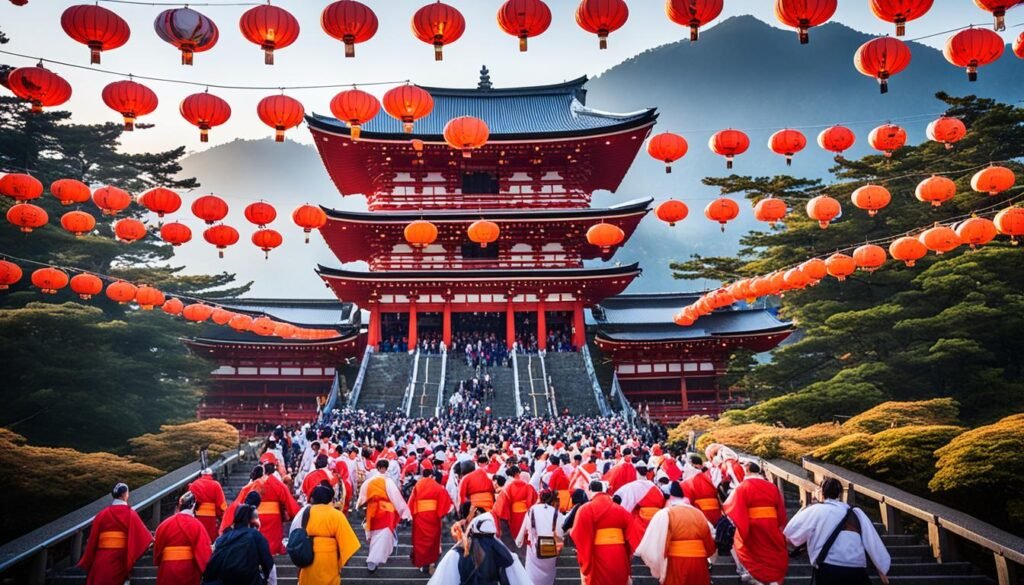
Sendai Tanabata Festival: A Celebration of Star-Crossed Lovers
The Sendai Tanabata Festival is from August 6th to 8th. It honors Orihime and Hikobushi, known as Vega and Altair. This legend tells of their reunion on a bridge formed by the Milky Way once a year.
Thousands of decorative ornaments adorn Sendai’s streets. They’re part of the festival, making the city center magical.
Decorative Ornaments and Fireworks Display
The festival kicks off with a grand fireworks display. This spectacular show lights up the night sky. Visitors have many good spots to see the fireworks from.
Festival Foods and Yukata Costumes
There’s a wide variety of food and drink stalls to enjoy. People love the festival foods. Many wear light yukata and comfy geta. This adds to the joyful summer atmosphere of the festival.
Kodo Earth Celebration: Rhythms of Sado Island
The Kodo Earth Celebration is a yearly music fest on Sado Island. It stars the Kodo taiko group from Japan. Lasting three days in August, the event pulls in a big crowd.
Outdoor Concerts and Fringe Events
The Harbour Market at Ogi Harbor lights up with evening concerts and shows at the Shukunegi Community Hall. There’s also lots of shops and food stands. It’s a chance to dive into the festival’s fun and see what the locals offer.
Taiko Drumming and Traditional Dance Workshops
Aside from the shows, there are also workshops on taiko drumming and traditional dance. At these, visitors can learn about Sado Island’s culture. It’s a way to get closer to the very heart of the island’s traditions.
Japan’s Fire Festivals: A Blazing Spectacle
Japan is known for its snow, flower, and dance festivals. There are also fire festivals that light up the night with traditional rituals. The Nachi Fire Festival happens on July 14th in Wakayama. Its main event features twelve burning portable shrines. This creates a beautiful scene that is like the Nachi Falls in fire and light. These fire festivals come from Shinto traditions and show a deep part of Japan’s cultural history.
Discovering Japanese Cultural Traditions
Japan is more than just its colorful festivals. It’s a place to deeply understand its cultural traditions. When you try out these unique customs, you really start to get Japan.
Stay the Japanese Way in a Traditional Ryokan
At a ryokan, you get a real taste of Japanese hospitality. Imagine sleeping on futons in tatami-mat rooms. Then, you can enjoy Japanese cuisine and natural hot springs. It’s an experience that takes you back in time to old Japan.
Learn the Basics at a Japanese Tea Ceremony
Joining a Japanese tea ceremony shows you how important rituals are in Japan. You will see and try the exact ways and manners used in this old practice. That way, you get why the cultural significance is so high.
Live Like a Monk with a Shukubo Temple Experience
Staying at a shukubo temple lets you live with Buddhist monks. You can join them in meditations and see their religious rituals. It’s a chance to see the quiet and spiritual side of Japan’s cultural traditions.
Japan also has more to explore beyond these. You can check out the geisha tradition, see a sumo match, try ikebana (flower arrangement), beat a taiko drum, or learn to make sushi in a sushi-making class. Each activity lets you dive deeper into Japan’s cultural heritage.
Immerse Yourself in Japan’s Vibrant Festivals and Cultural Traditions
Japan has a rich cultural heritage shown through its diverse festivals and traditional experiences. You can see this in the vibrant matsuri festivals with lantern parades and dance performances. Also, in the very traditional tea ceremonies and ikebana events. All these offer different ways to learn and join Japan’s customs and traditions.
Discover the Rhythm and Beauty of Matsuri
From the fire festivals to the Sapporo snow sculptures and Bon Odori dances, Japan has a lot to offer. These events allow you to explore the essence and beauty of its cultural heritage. By taking part in these cultural experiences in Japan, you’ll grasp the uniqueness and variety of Japanese culture.
Explore Japan’s Diverse Cultural Offerings
Japan’s traditional Japanese customs bring about many ways for visitors to dive in. This includes the tea ceremony and ikebana. Choosing a ryokan to stay, experiencing a shukubo temple stay, or learning taiko drumming can enrich your understanding. They provide a deep look at Japan’s lively cultural scene.
